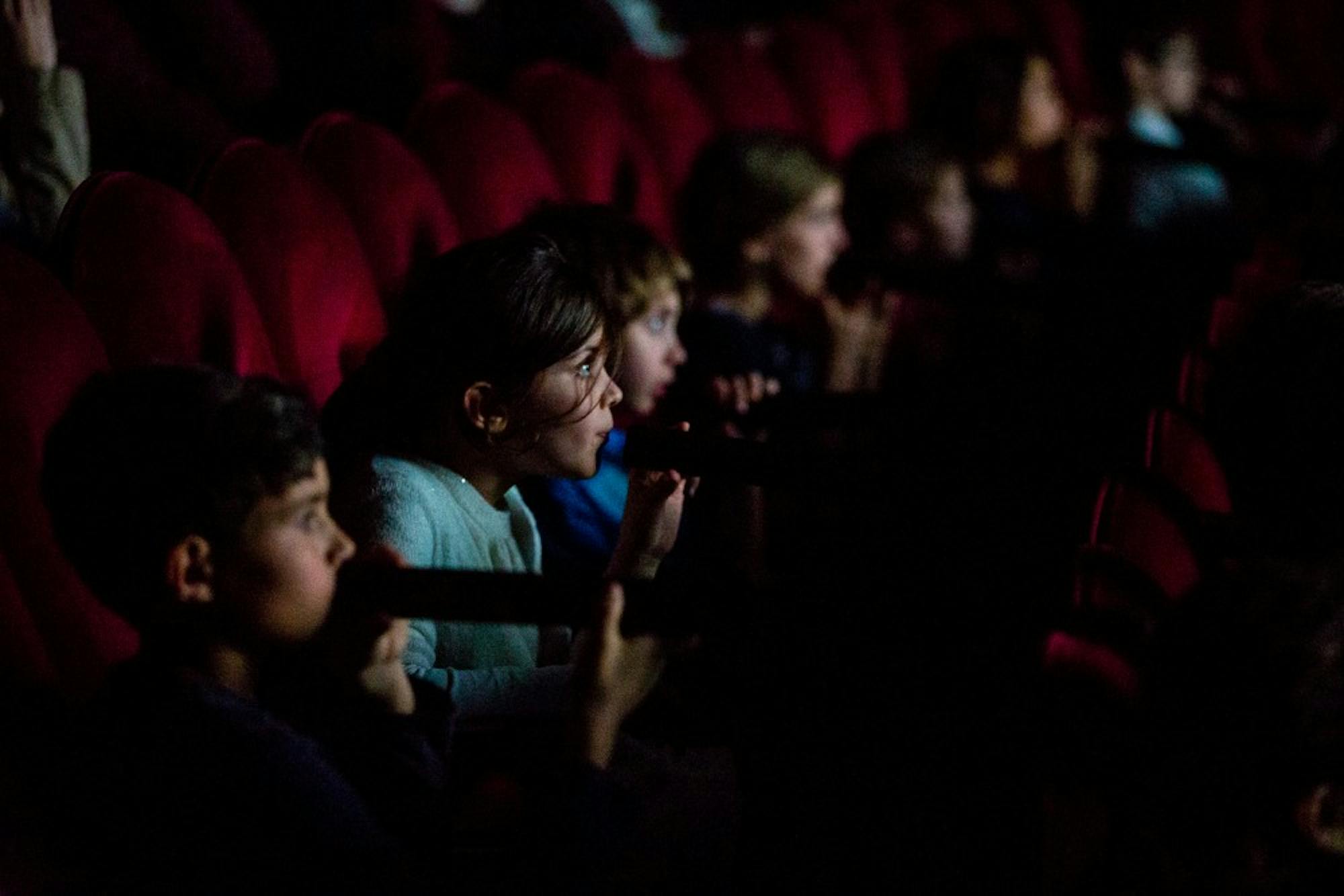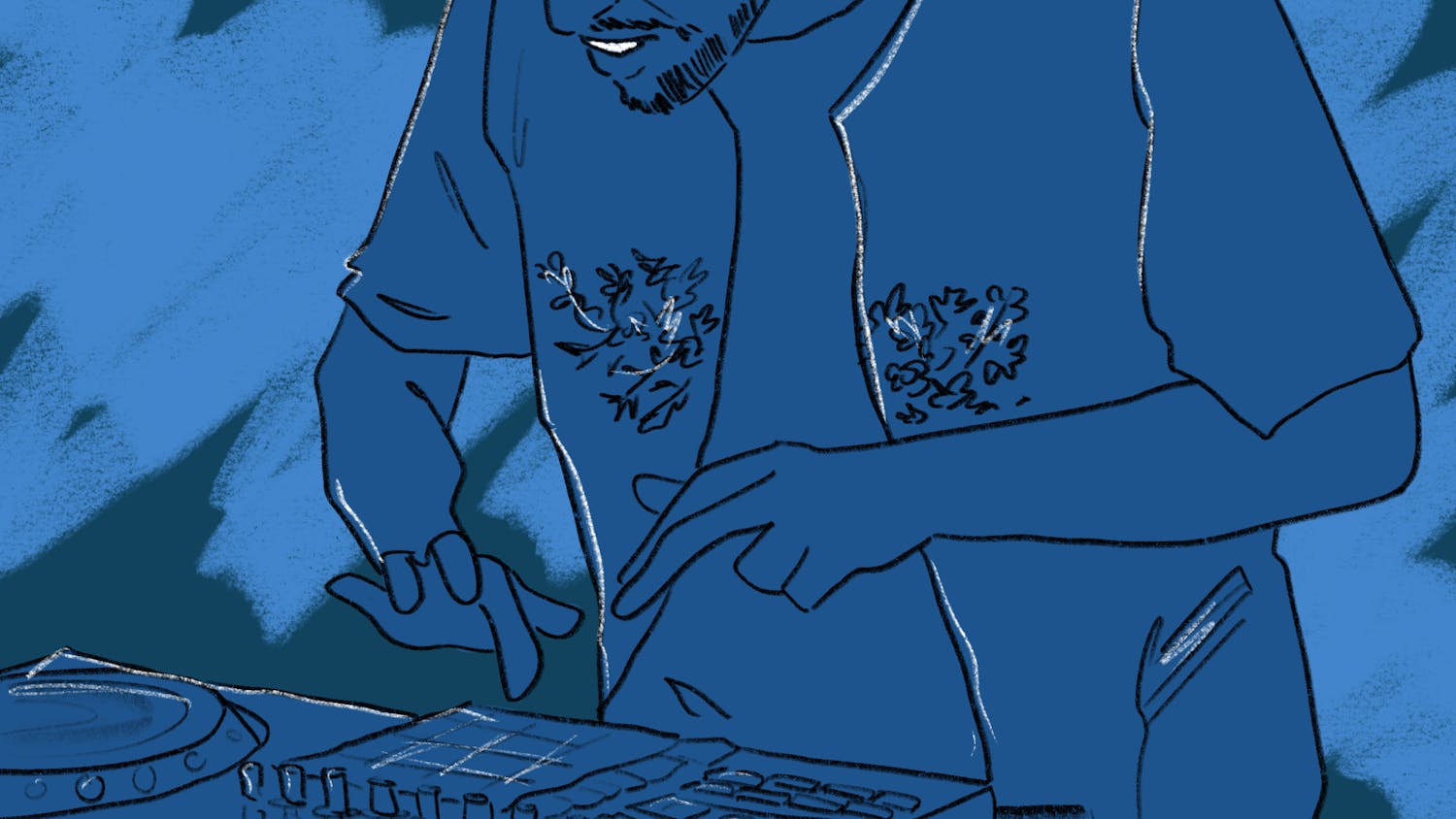The lights go down on an audience sitting in silent anticipation, and white sparks rain down the black screen. A second passes, then a white circle, like a searchlight, travels the edge of the picture and expands to fill the screen. In coordinated motion, audience members tie blindfolds around their eyes and wait for the show to truly begin.
From there, the small crowd enters a timeless limbo. The narrators — children, ages 9 to 11 — tiptoe in and line up behind the sightless audience to fit soft cones attached to hollow pipes over the viewers’ ears, each child whispering into one tube-end, “Can you hear me?” Everyone nods.
What follows is a journey through a room with white walls, through the pages of a big red book and through a projector screen with an umbrella-wielding stranger, over dirty floors and stones and egg shells. The audience exits in a daze half an hour or so later; all of us have attended the same film, but we leave with different images, the product of children’s words and of our own imagination.
This past Sunday, the Hopkins Center for the Arts presented “Blind Cinema,” a production created by European artist Britt Hatzius and presented by local children. The show was months in the making; Johanna Evans ’10, film programming and operations manager for the Hop, was brought on board to help plan the show starting in April and planning began in earnest in June.
However, preliminary organization began before April. The Hop’s previous program director, Margaret Lawrence, discovered the show at a presenting conference and was blown away, Evans said.
Evans said she first got involved because the show would be happening in the Hop’s theater and she understood the space and the technical needs, but she also became involved in recruiting child narrators because of her 9-year-old son.
“The Hop is sort of a jungle and a zoo and ... sometimes you come in here for a prepackaged experience where you know what you’re getting into,” Evans said. “You know what you’re signed up for, and it’s nice to have zoo experiences like that. But it’s also good to have jungle experiences where you’re out exploring on your own and you don’t know what you’re gonna find and it’s a little bit scary, and you’re really in the thick of it, encountering the art as it is. I feel like ‘Blind Cinema’ is one of these jungle experiences.”
For the audience, the show held an air of unpredictable mystery. Though observers understood the basic idea, few knew much beyond the blindfolds and the young narrators. Still, they were intrigued by the potential of an indescribable new experience. Before entering Loew Auditorium, Caroline Atwood ’21 said she looked forward to the mysterious production.
“It’s such an unusual event — I have no idea what’s going to happen, and I’m so excited,” Atwood said. “I feel like it’s going to be life-changing.”
After the show ended, Atwood said she left the auditorium still in awe.
“It was amazing,” she said. “It was everything I expected and more. Definitely the contrast between how kids view the world and how we view the world and the fragmentary nature of that was really shown.”
Hatzius said she wished to emphasize the difference between viewing through the eyes of children and those of adults.
“I’m not only thinking about the audience, I’m not only thinking about the kids — that’s really a combination of the two,” she said. “I think I was trying to create an experience that brings these two worlds together in a way where the child takes responsibility. Usually we have adults telling kids what to do, and here it’s kids telling adults not what to do, but what to imagine. There’s definitely a changing of roles, which I hope allows for the children to gain confidence of how they’re seeing and how they’re expressing themselves.”
Evans also felt intrigued by the change in the normal power dynamics in the show.
“I love the idea of overturning the traditional power dynamic between children and adults,” she said. “Often when children are brought into a theater space, they’re told to be quiet and sit still and keep themselves to themselves, and I really liked the idea of an experience for kids to be [part of] the theater.”
Hatzius said she found inspiration in a variety of areas.
“I have a visual arts background and I was making films, and I realized at some point that we live in a time where there’s an overload of images — [we’re] kind of bombarded by them — and I wanted to see what happens when you don’t see,” she said.
She started researching people who perceive the world differently without visual medium and found audio-description, which uses narrators who have watched a movie a few times to describe the images for those who cannot see them.
“Especially [recent] American films ... they are actually required to have an audio-description track on their films for people with impaired sight,” she said.
However, the “Blind Cinema” narrators differ from those who do audio-description. They do not see the film before the show, and the movie is only screened once to ensure that it is an entirely unique experience for all parties involved, Hatzius said. The narrators are also much younger than typical audio-descriptors.
“This age range is also very particular — between 9 and 11 — because they’re in the middle of discovering the potential of language, but they’re also fluid enough to be able to just do [narration] without thinking too much,” she said. “So that’s one reason, and also just to highlight the fact that everybody has a different way of seeing and a different way of describing ... the idea of it is really to let them speak, to let them decide how they want to describe something.”
Evans’s 9-year-old son, Finn, said he enjoyed watching the movies for “Blind Cinema” as a narrator. When asked about the experience of narrating to adults, he said he felt that he was under pressure, but being anonymous took some of the pressure off.
To this day, Hatzius said she has not gotten any complaints from her audience. She said she found it interesting to see a group of blindfolded people sit in a cinema, which is visually oriented toward a screen.
“It’s a strange situation itself, so a lot of the times when I describe it to somebody … first of all, they’re very curious,” she said. “A lot of people have actually never sat blindfolded for that long — for 35 minutes.”
Hatzius, who said she sought to create an experience that showed how everybody sees, experiences, reads and interprets differently, has since brought the show to 14 countries in 10 different languages.
“I never really go out thinking I’m going to accomplish something for sure with my work, but I think that what I try to do ... is to create a piece that has many different layers ... I think I was trying to create an experience that brings two worlds together in a way where a child takes responsibility,” she said.




